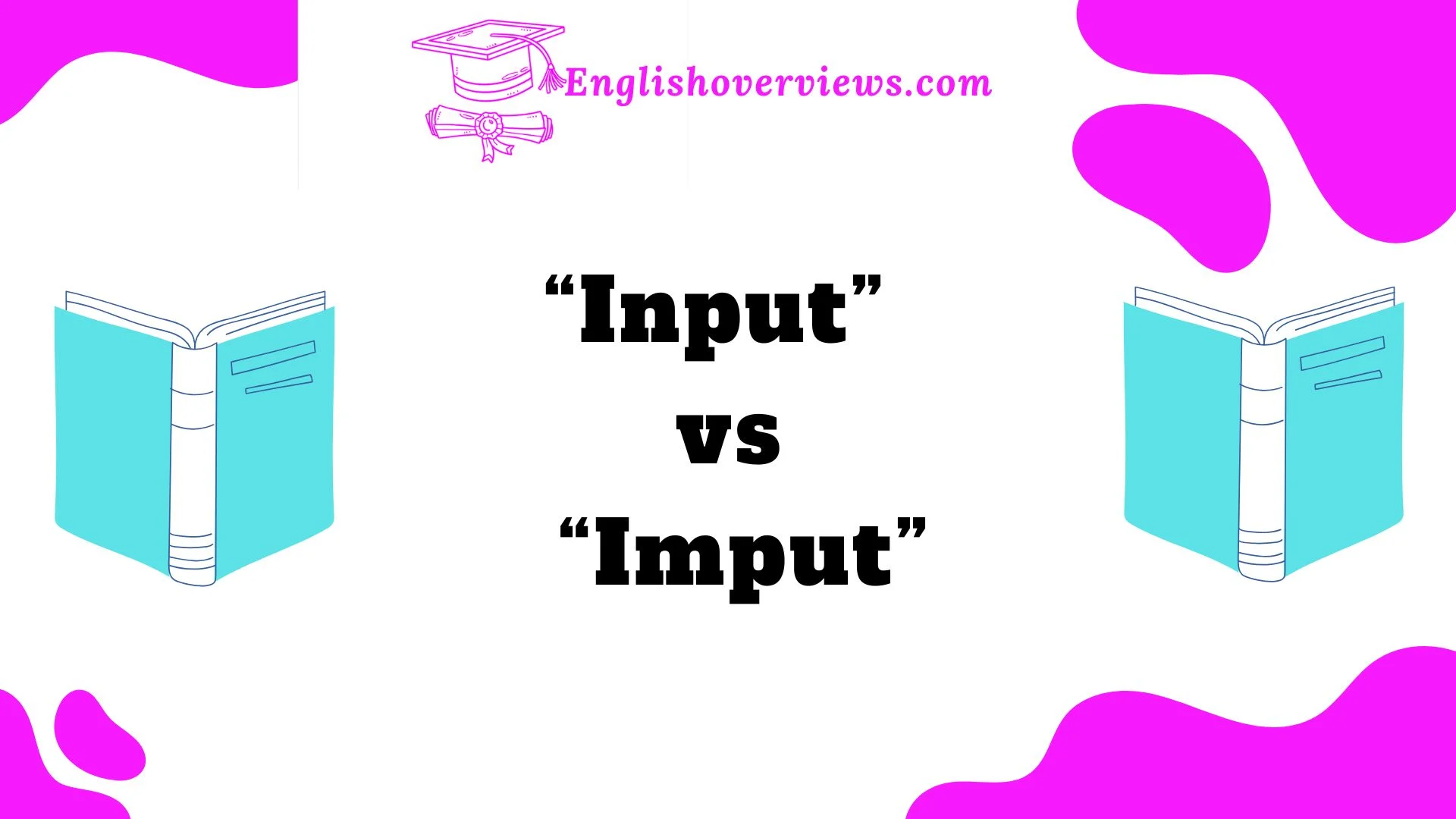In the world of words, accuracy matters, especially when certain terms are often confused. The words “input” and “imput” are a prime example of this common linguistic mix-up. If you’ve ever wondered which one is correct, even caught yourself hesitating while typing it you’re not alone. This guide dives deep into the difference between these two terms, revealing why one is correct and the other is not.
Understanding language nuances like this isn’t just about writing better emails or documents; it can also enhance your communication skills, whether you’re working in technology, business, or education. By the end of this article, you’ll have a crystal-clear understanding of “input,” its proper usage, and why “imput” isn’t a real word.
Let’s explore the origins, correct grammar, and practical examples of “input” to ensure you’re always using it the right way. Stick around for tips, real-world examples, and FAQs to further cement your understanding.
Understanding the Confusion Between “Input” and “Imput”
Why is There Confusion?
The confusion between “input” and “imput” arises from:
- Phonetics: Both words sound similar when spoken quickly, leading to spelling errors.
- Autocorrect Mistakes: Sometimes, technology itself suggests or accepts “imput” as correct.
- Regional Accents: Pronunciation in certain regions might make “input” sound closer to “imput.”
However, let’s make one thing clear: “Input” is the only correct word. The word “imput” does not exist in standard English and is not recognized by reputable dictionaries.
Fun Fact: Common English Spelling Errors
According to a study by the University of Cambridge, 30% of writing errors occur due to phonetic similarities, where people write words as they sound rather than how they’re spelled.
What Does “Input” Mean?
Definition and Linguistic Breakdown
The term “input” functions as both a noun and a verb. Its meaning largely depends on context:
- As a noun: Refers to ideas, contributions, or data provided for consideration or processing.
- As a verb: Indicates the act of entering data or providing feedback.
Everyday Uses of “Input”
Here are examples of how “input” is used:
- In conversations: “I’d appreciate your input on this project.”
- In business: “We need more input from stakeholders before finalizing the report.”
- In technology: “Please input your password to log in.”
Tracing the History of “Input”
The word “input” originated in the 17th century, derived from the Middle English term “in putten,” meaning “to put into.” Over time, its meaning expanded, especially with the rise of technology and computing.
Etymology at a Glance:
| Time Period | Origin | Meaning Evolution |
| 1600s | Middle English “in putten” | Physical act of placing |
| 1900s | Computing era | Entering data or commands |
| Modern Usage | Broad contexts | Includes feedback, ideas, etc. |
This evolution highlights how input became synonymous with contributing or feeding something into a process.
The Correct Usage of “Input” in American English
In American English, “input” follows standard grammatical rules. Here’s how to use it correctly:
Examples of Input as a Noun
- “Her input was invaluable to the team.”
- “We need to collect customer input before launching the new product.”
Examples of Input as a Verb
- “He input the data into the system.”
- “You can input your preferences into the app settings.”
Note: In some cases, “inputted” is debated as a past tense of input. However, “input” is more commonly accepted in both past and present contexts.
Why People Mistake “Input” for “Imput”
Common Causes of Missteps
- Mispronunciation: In casual speech, “input” might sound like “imput.”
- Fast Typing: Typographical errors can lead to misspelling.
- Lack of Proofreading: Errors often go unnoticed in informal writing.
Real-Life Example
Imagine someone typing up meeting notes in a rush. They write, “Your imput is important.” A simple spelling error could make the writer appear careless or unprofessional.
Quick Fix: Always proofread and rely on tools like Grammarly to catch such mistakes.
Real-Life Contexts Where “Input” is Commonly Used
Communication and Feedback
In workplaces, input refers to valuable feedback or ideas that contribute to decision-making. For example:
- During a team meeting, a manager might say, “We need everyone’s input to finalize this project.”
Technology and Data Entry
In computing, input involves entering data or commands into a system. Examples include:
- Typing on a keyboard (input device).
- Feeding numbers into a financial model.
Decision-Making
Input is critical for collaborative efforts. Consider this:
- A company launching a new product often collects customer input to gauge interest and improve design.
The Role of “Input” in Computing and Digital Interfaces
Input Devices and Systems
In technology, input devices play a crucial role. These devices enable users to communicate with computers or systems.
| Input Device | Function |
| Keyboard | Text and command input |
| Mouse | Pointing and selection |
| Microphone | Voice input |
| Sensors | Detect environmental changes (e.g., temperature) |
User Interaction
Modern interfaces rely heavily on input to personalize user experiences. For instance:
- Search engines analyze user input (search queries) to provide relevant results.
- Smart home systems adjust settings based on sensor inputs.
Comparing “Input” as a Noun and a Verb
Dual Role Explained
- As a noun: “Input” refers to data or feedback provided.
- As a verb: It describes the act of entering or providing data.
Examples for Clarity
| Context | Noun Example | Verb Example |
| Technology | “This device requires input.” | “Please input the password.” |
| Feedback Collection | “Your input is appreciated.” | “He input his suggestions.” |
Common Misconceptions About “Input”
- “Inputted” as Past Tense:
- While “inputted” is sometimes used, “input” is the more widely accepted past tense.
- Example: “I input the data yesterday.”
- Plural Form Confusion:
- People often wonder about the plural of “input.” It remains “input” in most contexts.
Demonstrating Proper Usage of “Input” with Examples
Sentence Examples
- Noun: “The team valued her input during the brainstorming session.”
- Verb: “You need to input your information on the registration page.”
Exercises to Practice
Try rewriting these sentences with the correct form of “input”:
- The system cannot process your [input/imput].
- Please [input/imput] your email address here.
Why “Imput” is Incorrect: A Final Clarification
Key Takeaways
- “Imput” is not a recognized word in standard English.
- Always use “input” in both spoken and written contexts.
Tips for Remembering the Proper Spelling and Usage of “Input”
- Mnemonic Device:
- “I put my ideas into the system” (helps you recall “input”).
- Proofread Regularly:
- Reread your text to catch and correct spelling errors.
- Use Grammar Tools:
- Leverage apps like Grammarly to avoid mistakes.
Final Thoughts on “Input” vs. “Imput”
The word “input” plays a vital role in communication, technology, and decision-making. Understanding its correct usage will help you avoid errors and communicate more effectively.
Remember: “Input” is always the correct choice.
FAQs
Q: Is “imput” ever correct in English?
A: No, “imput” is not a valid word. Use “input” instead.
Q: What’s the plural of “input”?
A: The plural remains “input” in most contexts.
Q: Can “input” be used as a verb?
A: Yes, for example: “Please input your details.”
Q: Is “inputted” correct?
A: While debated, “input” is preferred as both the past and present tense.
Q: How can I avoid spelling errors with “input”?
A: Proofreading and grammar tools like Grammarly can help

Alyan Ashraf is the creative mind behind English Overviews, a platform dedicated to helping learners master the English language. Passionate about education and language development, Alyan specializes in simplifying complex English concepts, making learning accessible for students of all levels.











